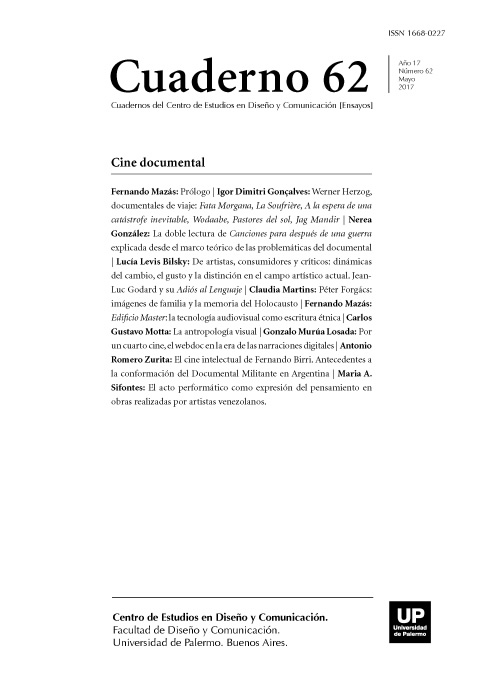Werner Herzog, documentales de viaje: Fata Morgana, La Soufrière, A la espera de una catástrofe inevitable, Wodaabe, Pastores del sol, Jag Mandir
Abstract
Four films by the german director Werner Herzog are analyzed as travel film essays. These works, less known, short films, that are supposed to risk less, or in other words, those works of physical research of documentary creation in the very action of observation illustrates a personal tour through more conventional ways to make documentaries. This article argues that, on one hand, in these movies the author applies a staging that comes from Paul Rotha´s naturalism and his romantic device; and on the other hand, that what Herzog adds is neccesarily what moves them away from a container definition. The value of these film essays lies in the use of the classic tools with new meanings given by the author. In this article we reflect about the trouble in detect patterns in documentary cinema after the case-study of one author´s filmography.
References
Nichols, B. (1997). La representación de la realidad, cuestiones y conceptos sobre el documental. Buenos Aires: Paidós.
Nichols, B. (2001). Introduction to Documentary. Bloomington: Indiana University Press.
Shaeffer, J. M. (1990). La imagen precaria del dispositivo fotográfico. Lavel: Ediciones Cátedra.
Dubois, P. (1986). El acto fotográfico, de la representación a la recepción. Paidos Iberica Ediciones.
Rotha, P. (in collaboration with Sinclair Road y Richard Griffith) (1936). Documentary Film, The use of the film médium to interpret creatively and in social termis the life of the people as it exists in reality. Londres: Faber and Faber.
Grierson, J. (2014). Postulados del documental. Disponible en: http://www.catedras.fsoc.uba.ar/decarli/textos/Grierson.html
Chanan, M. (2007). The Politics of Documentary. Londres: British Film Institute.
Herzog, W. (1999). Declaración de Minnesota. Verdad y hechos en el cine documental. Walker Art Center, Minneapolis, Minnesota.
Comolli ,J. L. (2007). Ver y poder: la inocencia perdida: cine, televisión, ficción, documental. Buenos Aires: Aurelia Rivera: nueva librería.
Cronin, P. (2014). Herzog por Herzog: entrevistas y edición de Paul Cronin. Ciudad Autónoma de Buenos Aires: El cuenco de plata.
González, L. (2013). Werner Herzog: El Documental como indagación fenomenológica. Revista Questión, Vol. 1, No 40, Octubre - Diciembre 2013. La Plata: Universidad Nacional de La Plata.
Bernini, E. (2012). Territorios audiovisuales, Cine video, televisión, documental. Instalación, nuevas tecnologías, paisajes mediáticos. Jorge La Ferla y Sofía Reynal, (comp.). Buenos Aires: Libraria.
Russel, C. (1999). Experimental Ethnography. Durham and London: Duke University Press. Burke, E. 1729-1797, Uma investigação filosófica sobre a origem de nossas idéias do sublime e do belo; Tradução, apresentação, notas: Enid Abreu Dobránszky. - Campinas, SP : Papirus : Editora da Universidade de Campinas, 1993.
Filmografía
Flaherty, R. (1922). Nanook, el esquimal. Disponible en: https://www.youtube.com/watch?v=_f8J9NRchOE
Herzog, W. (1971). Fata Morgana.
Herzog, W. (1977). La Soufrière - Warten auf eine unausweichliche Katastrophe.
Blank, L. (1982). Burden of Dreams.
Herzog, W. (1989). Wodaabe - Herdsmen of the sun.
Herzog, W. (1991). Jag Mandir.
Los autores/as que publiquen en esta revista ceden los derechos de autor y de publicación a "Cuadernos del Centro de Estudios de Diseño y Comunicación", Aceptando el registro de su trabajo bajo una licencia de atribución de Creative Commons, que permite a terceros utilizar lo publicado siempre que de el crédito pertinente a los autores y a esta revista.


